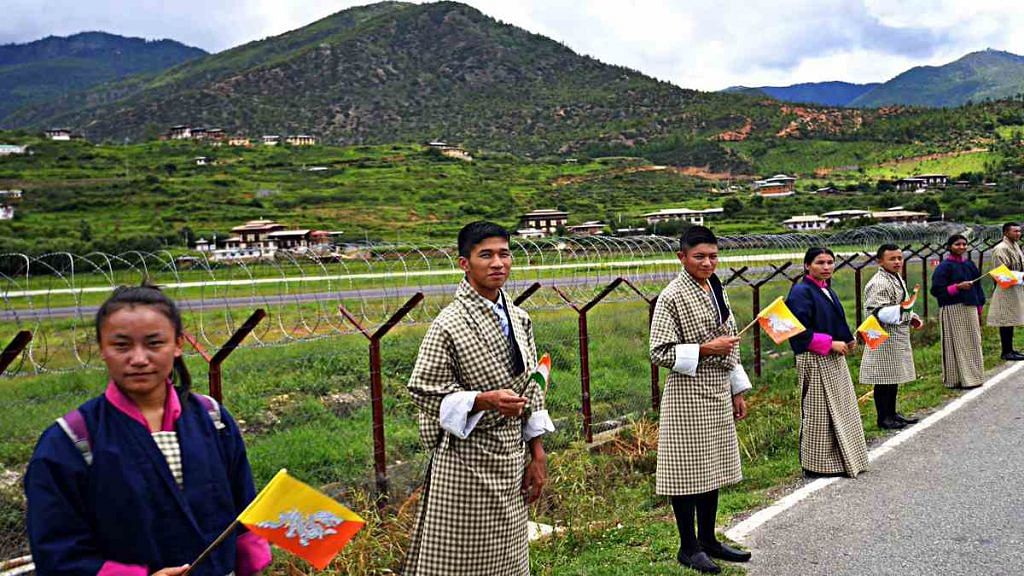New Delhi: India is pushing Bhutan to settle its border issue with China to enable New Delhi to define the trijunction area of Doklam, ThePrint has learnt. There are, however, fears that Beijing is doing a South China Sea in Bhutan — gradually taking over land.
According to official sources, India is concerned that Beijing is raking up the border issue with Thimpu to harass New Delhi due to the ongoing border dispute at the Ladakh sector along the Line of Actual Control (LAC).
Sources, however, said Bhutan will now have to take a “strong stance” against China before it becomes too late for them to start negotiations on the border issue. This will enable India to push China to discuss the trijunction area around Doklam.
“They have their own talks with China on boundary and are keen to reach settlement. This will also help us define the trijunction,” a top official told ThePrint on condition of anonymity.
Last week, a Chinese journalist sparked controversy after tweeting, and then deleting, the map of a new village of the country. Satellite imagery analysts claimed the village was two kilometres inside Bhutanese territory and near the Doklam Plateau but Bhutan has contested the analysis.
Major General Vetsop Namgyel, Ambassador of Bhutan to India, denied the claims of Chinese villages inside the territory of his country. “There are no Chinese villages inside Bhutan. These satellite images are all incorrect … Yes, we have border discussion going on with China and that process is on,” he told ThePrint.
Bhutan and China have held 24 rounds of border talks bilaterally.
Also read: Chinese defence minister to visit Kathmandu, 2 days after Foreign Secretary Harsh Shringla
‘Beijing doing a South China Sea in Bhutan’
Sources said India believes Beijing is following its South China Sea strategy — where it kept pushing for territory and eventually brought in civilian populations — in Bhutan.
“China is now doing in Bhutan what it did in the South China Sea — first create settlements and then bring in civilian population so that it becomes more complicated for them to settle the matter soon,” said a source. “This in turn, makes it more difficult for India also to bring up the tri-junction issue with the Chinese.”
The source added that China is making all possible attempts to change the status quo at Doklam and putting pressure on India but “harassing” Bhutan.
According to a former Indian Ambassador to China, who did not want to be named, this is an “old tactic” of Beijing. “They change the facts on the ground, change the status in the disputed areas and then put their territorial claims,” the former diplomat said.
Also read: Eyeing China, NSA Doval looks to promote Indo-Pacific strategy in Sri Lanka
‘Potential of flare up in Doklam remains’
On 28 October, a US-based satellite operating firm claimed that China has been carrying out roads and construction activities along the Torsa River Valley area near Doklam, which had been the main theatre of a 73-day border standoff between India and China in 2017.
According to sources, Doklam continues to be an “area of concern” that has the potential to flare up again. But with the Ladakh standoff dragging, New Delhi is not putting much focus on that side for now.
The Doklam plateau remains hugely critical for India due to the Siliguri Corridor that lies to the south of Doklam. The corridor, also known as the ‘Chicken’s Neck’, is a 22-km wide major arterial road connecting mainland India with its northeastern states and thus it is a highly sensitive area for China.
“Wedged between Bangladesh to the south and the west and China to the north, the Siliguri Corridor also links India to neighbouring Nepal, Bangladesh and Bhutan,” Syed Fazl-e-Haider, an analyst, has written in a paper for The Lowy Institute. By an advance of just 130 kilometres, the Chinese military could cut off Bhutan, West Bengal and the north-eastern states of India. About 50 million people in northeast India would be separated from the country.”
Phunchok Stobdan, veteran diplomat and an expert on India-China relations, said India should not push Bhutan too much on this matter as that can worsen the situation.
“Bhutan has to balance its ties with India as well as China. At the same time India should not push Bhutan too much and continue to maintain soft diplomacy there,” he added. “There are many other channels that India can activate with Bhutan when it comes to the highly sensitive matter of settling the boundary dispute between them and China.”
Also read: India sees ‘strong interlocutor’ in Antony Blinken, Biden’s choice for US Secretary of State
